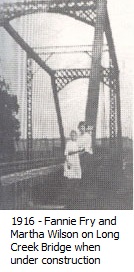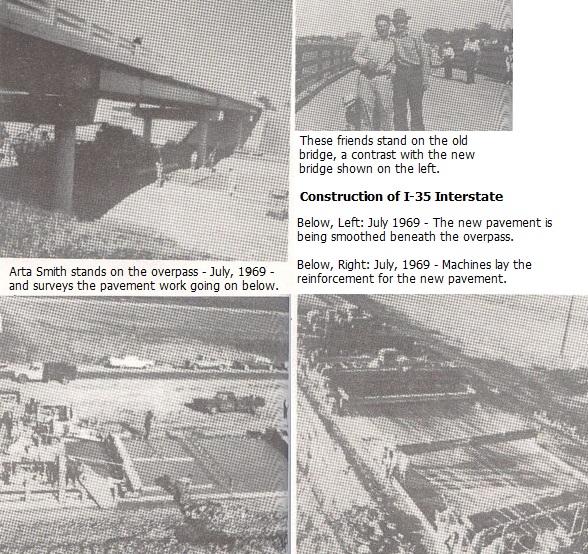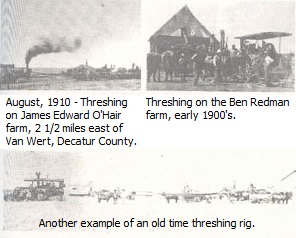

'A CENTURY OF MEMORIES'
1880 - 1980 |
 Prior
to the year 1854, the territory on which the town of Van Wert now stands
was in the midst of an almost limitless expanse of gently rolling
prairie with a small amount of timber. Prior to the coming of the
settlers, this section was claimed by the red man. In 1854, several
emigrants began a settlement here in Long Creek Township. Lambert Taylor
and Mr. J. Irving conceived the idea of adding materially to their
wealth by locating a town on their lands. Thus, the first road running
north and south between their lands was established. This has always
been called Main Street. Prior
to the year 1854, the territory on which the town of Van Wert now stands
was in the midst of an almost limitless expanse of gently rolling
prairie with a small amount of timber. Prior to the coming of the
settlers, this section was claimed by the red man. In 1854, several
emigrants began a settlement here in Long Creek Township. Lambert Taylor
and Mr. J. Irving conceived the idea of adding materially to their
wealth by locating a town on their lands. Thus, the first road running
north and south between their lands was established. This has always
been called Main Street.There was an early post office called Patriot that was located in a private home two miles east of Van Wert. We can only presume that what is now a black top road No. 258, that goes to Highway 69, began as a wagon trail. On an automobile map of 1914, this road was called the Corn Belt Highway. It was marked on telephone poles with two yellow stripes painted with a black stripe between, later metal signs. Records show that Highway 69 was once called "From Palm to Pines" but the 1914 map lists it as two highways. One was Jefferson Highway - marked telephone poles with two blue stripes and a white stripe between with a JH symbol on the white. At this same time this highway also had sign posts that read "St. Paul, Des Moines, St. Joe and Kansas City" Interstate Trail. This same highway was changed to number 65 and 69 running together at a later date. This road was graded in the 1920's with teams of horses and lots of hard work. It is now known as Highway 69.  Mud
roads - how well many of us remember them! Soon after the paving of
Highway 69, just east of Van Wert in 1930, Van Wert was given an all
weather road. The first graveled road in Long Creek Township was along
the south side in 1935. Just south of Van Wert, 1 1/2 miles of road was
graded up by hand by the WPA workers and graveled in 1936. By the early
1950's, most all of our roads were graveled. Mud
roads - how well many of us remember them! Soon after the paving of
Highway 69, just east of Van Wert in 1930, Van Wert was given an all
weather road. The first graveled road in Long Creek Township was along
the south side in 1935. Just south of Van Wert, 1 1/2 miles of road was
graded up by hand by the WPA workers and graveled in 1936. By the early
1950's, most all of our roads were graveled.December 17, 1969, marked the opening of Interstate 35 from Osceola on No. 34 and to Decatur on No. 2. Interstate 35 runs through the west section of Van Wert's city limits. Interstate 35 gave Van Wert, formerly an end-of-the-road town, a "back-door" entrance. |
 |
| Van Wert Farmers and Agri-Business |
 It
all started on the land. Where the sod was broken, other commerce and
industry followed. Some would say that in southern Iowa, the railroads
paved the way, and this is true. In fact most early homestead purchases
in Decatur County were from tracts of land owned by the railroad or the
government. It
all started on the land. Where the sod was broken, other commerce and
industry followed. Some would say that in southern Iowa, the railroads
paved the way, and this is true. In fact most early homestead purchases
in Decatur County were from tracts of land owned by the railroad or the
government.In the Van Wert area 100 years ago, the Keokuk-Western and the Des Moines-Kansas City lines made up the rail service (including the Humeston-Shenandoah). But looking at our nation at that early date, we see that a main function of railroads was to carry people, goods, and produce, and without the farmers, railroads and towns which sprang up along the way, would have had little to serve. conversely, farmers relied on the towns for tools, implements, seeds, and other goods to carry on their enterprises, and they relied on the railroads to bring these goods in. Without a big argument concerning the "chicken and egg" theory, it would suffice to say that to the coming of railroads and homesteading, towns owe their beginning. The same is true of Van Wert. Of course, steam engines were well in use before the turn of the century. Owners of threshing rigs in the Van Wert area at an early date that people have mentioned were: Showers and Liggitt, Horney Bros., Jack Lee, Vern and Clair Parmer, Delbert and Bill Ramsey, Alva Foland, Sharon Twombley, Charley Davis, John Bill Bahr, Fred and Bill Beers. Jack Lee worked with a Rumley separator threshing machine powered by a Russell engine. He had different partners in this enterprise. Jack later changed to a Case tractor. Sharon Twombley had a 22' Red River special threshing machine powered by a 15-30 International Tractor. Alva Foland had a Rumley oil pull tractor on his threshing rig. Fred Beers had a Case separator pulled by a steam engine. Bill Beers and Fred also sawed wood with a Hart-Parr tractor at one time. Merlin Oiler was well known for his ability to stack straw right as it came out of the blower. He always wore a pair of goggles and didn't want anyone else on the stack with him. Merlin usually went barefooted so he really practiced his boxing ability on that straw stack. Nolan Foland and Jesse O'Hair were the first in the area to start farming with tractors as well as horses. They both had a B John Deere with steel wheels. James A. O'Hair had a B Farmall. Floyd Boles had one of the first F12 International tractors on steel. Charlie Johnson and Levi Cochran had one of the first W.C. Allis Chalmers. Levi had a custom feed grinder mounted on a Model A truck. Harold Pearcy and Ray O'Hair did custom hay baling with the old square wire-tie balers pulled and powered by small farm tractors. Harley Heckathorn did custom wood sawing. He had a 6-horse Whitte engine. He pulled it from one job to another with a team of horses. Several sorghum mills were around the community. Some were operated by Lonnie Cowden, Erastus Wilson, Lou Green and Homer Ramsey. |
| MAKING SORGHUM |
| Each spring cane was planted in rows and cultivated. By the middle
of August, it was ready to be stripped. This was done by someone walking
each row with a sharpened lath to break off the leaves. When all of the
leaves were off, the tops of the cane were cut off with a corn knife.
Finally, the stalk was cut off and loaded on a hayrack to be taken to
the mill. The cane was fed into the press and the juice put into large
vats and cooked for five or six hours. It was then skimmed and put in 5
or 10 gallon cream cans to cool. After cooling, the sorghum was then
transferred to gallon jars. In the 1970's, Lonnie and Ruby Cowden made sorghum at the Walt King farm. (They usually made about 75 gallons a year.) In 1971, Pete Scadden helped haul in the cane. Others helping with stripping, topping and cutting cane were Charita Cox, Debby Fisher, Ted Cox, Randy Cowden, Teddy Scadden, Coy Cowden. Elmer and Uriah Ramsey owned and operated a steam engine saw mill. Joshua West marketed his hogs, one or two at a time by supplying Van Wert's store with fresh butchered pork every week. Fred Wesley Gill, son of James Milton Gill and Blanche Burchett, who were married in 1916, lived on a farm 5 miles southwest of Van Wert, near DeKalb until 1939. The farm consisted of over 960 acres and was called the Hepburn farm. It was farmed with horses and mules and it was the first farm in the county to have Deer and Beavers released on it by the Conservation Commission. It was also the first farm to use poison bran to try to destroy the Cinch bugs. Donald Morris worked for Fred Gill for 20 years. Fred's three girls rode on horseback the five miles night and morning to attend school in Van Wert. Fred helped with the homecomings and ran the dances on Saturday nights. It's always fun to compare farms, say in the rural Van Wert area of today, vs. 100 years ago. Think of an operation in 1880: one hundred sixty acres, 1/4 section, was a big farm. Many farm units were only eighties, forties or less. There was no electricity, no gas, no refrigeration. Butchering had to be done in the winter time, or if not the meat had to be readily salted away or cured. Transportation essentially was by horse and buggy; train, if you cared to venture far. Entertainment was simple and locally derived. Movies weren't known yet. Kerosene or coal oil lamps made up the lighting. Wood or coal heated the home and cooked the meals. The farmer was basically subsistent. Some produce and livestock was sold in trade for the basic necessities; salt, sugar, coffee, seed, fencing, tack, hardware, and maybe some cloth goods for making clothing. Farms were still feeding few people besides their own families. Now 380 acres is just an average size farm. Farming is basically big business. One tractor replaces a team of draft horses easily, chemicals kill weeds, commercial fertilizers replace soil nutrients, and on several farms, crops go in the ground with little or no tillage at all. In some instances, plows are implements of the past. Pages 20 - 26 |
| Century of Memories Index *** History Index *** Decatur County IAGenWeb |